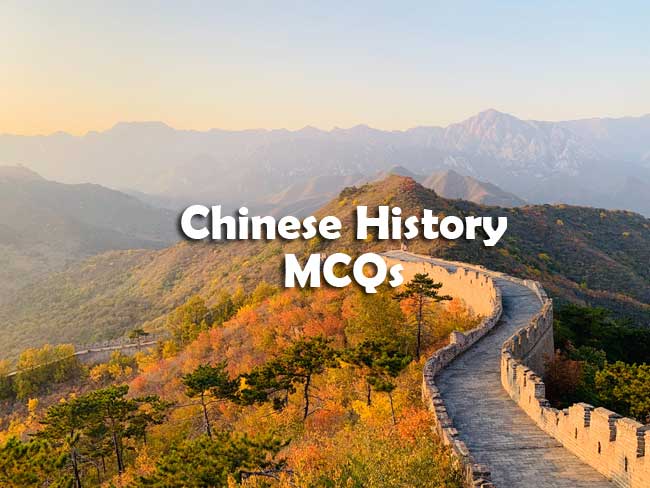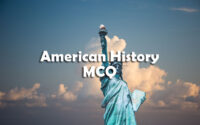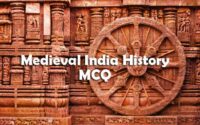Chinese History Questions and Answers
Last 5 years Chinese History Questions and Answers Papers provided here. Candidates who are applied for the competitive exam can check and download the Chinese History Trivia MCQ from here. We have updated history of Chinese topics GK Papers to present you a scheme on how to plan for the exam.

Download pdf Chinese history GK quiz Last Year Solved Question Papers from the link provided. Therefore, if you are among the one who is searching for the Chinese history quiz Old Papers, then you can check here. Hence, go through the following sections and download the Chinese quiz Model General Knowledge Question Papers Pdf.
Interested aspirants can also check the Chinese quiz Test Pattern.
Questions and Answers on Chinese History
1. Which among the following is not Ming loyalist movement?
(A) The Heaven and Earth Society
(B) The White Lotus Sect
(C) Triad Society
(D) The Boxers
2. A kowtow is:
(A) 2 kneelings and 9 knockings
(B) 3 kneelings and 9 knockings
(C) 2 kneelings and 8 knockings
(D) 3 kneelings and 8 knockings.
3. The Ch’ings established themselves in Peking in:
(A) 1644
(B) 1645
(C) 1646
(D) 1647
4. Who abdicated the throne in 1795?
(A) Abahai
(B) Yung –cheng
(C) Shun-chin
(D) Ch’ien-lung
5. The Manchus were the nomadic tribes living in present day
(A) Manchuria
(B) Korea
(C) Mongolia
(D) None of the above.
6. The greatest literary contribution of emperor Ch’ien-lung was the compilation of
(A) A record of ten perfect accomplishment
(B) A discourse on parties and cliques
(C) The complete library of the four treasuries
(D) None of the above
7. The most important organ in the Ch’ing administration after 1729 was
(A) The Six Boards
(B) Civil Office
(C) The Grand Council
(D) Bannermen
8. The major function performed by the gentry in the local community was
(A) compiling and updating genealogies
(B) aiding clan members
(C) educating young clan members
(D) The settlement out of court of civil disputes
9. Who were the most important single group in Chinese society?
(A) Government officials
(B) Gentry
(C) Artisans
(D) Merchants.
10. On the first day of the provincial examination, the candidates had to write three essays on subjects chosen from:
(A) Confucian Four Books
(B) Five Classic
(C) Historical subjects
(D) Current problems.
11. No one was allowed to be appointed to a high position in his native province by the:
(A) Law of Inheritance
(B) Law of appointment
(C) Law of avoidance
(D) None of the above
12. At the bottom of the provincial administration was:
(A) Province
(B) District
(C) Prefect
(D) Circuit
13. In the Chinese society, every ten household form a:
(A) Pau
(B) Li-chia
(C) Pai
(D) None of the above
14. A census was taken on the basis of land and poll tax after every 5 years since:
(A) 1653
(B) 1654
(C) 1655
(D) 1656
15. A recent view appraises the Chinese society as an archetype of:
(A) Feudal system
(B) Oriental despotism
(C) A gentry-based elite
(D) Bureaucratic system
16. Which province was allotted the highest quota in the district examination?
(A) Chihli
(B) Szechuan
(C) Kansu
(D) Kiaotung
17. Before 1850, the average total number of the gentry was about:
(A) 1 million
(B) 1.1 million
(C) 1.2 million
(D) 1.3 million
18. The Chinese emperor made offering to heaven, in times of
(A) Natural calamities
(B) War
(C) Victory
(D) None of the above
19. The nobility of the Ch’ing system consisted of :
(A) Dalai Lama, The Chief Taoist. The Duke King
(B) Two categories such as the six board and nine minister
(C) Three categories such as imperial clansmen, titular nobles and bannermen
(D) Officials and Gentry.
20. The clansmen numbering about 700 from the late 16th century through the end of the 19th century were the direct descendants of:
(A) Duke K’ung
(B) Nurhaci
(C) Dalai Lama
(D) Karmapa
| World History | American History |
| Japanese History | European History |
| Chinese History | Asian History |
21. After the first Ming emperor abolished the office of the prime minister in 1380, the most important organ in the central government till 1729 was:
(A) The Grand Secretariat
(B) The Grand Council
(C) Civil Office
(D) Governors.
22. In the early and middle Ch’ing period, the land tax was the greatest of all taxes, the basis of its collection was the 1646 edition of the Fu-I ch’chuan-shu, (complete tax of land and labor), which include:
(A) The total amount of cultivated land in the country, quotas of land and labor imposed in various provinces
(B) The total amount of their produce
(C) The total amount of the population in the area
(D) Total number of taxable men.
23. The land measurement registers showed the total land area in each locality, this register was called:
(A) Yellow registers
(B) Fish-scale registers
(C) Bannermen
(D) None of the above
24. In the Ch’ing period, the method of tax collection was the Single-whip system, which consolidated all taxes into one compound sum to be paid twice a year, the two payment known as ‘the upper busy season’ and ‘the lower busy season’ which was:
(A) Summer payment and autumn payment
(B) Summer payment and winter payment
(C) Winter payment and autumn payment
(D) None of the above.
25. The largest items of debit during the Ch’ing period were:
(A) Military expenditures and promoting education
(B) Military expenditures and officials’ salaries and allowances
(C) Officials’ salaries and repairs of rivers and ponds
(D) Official salaries and Public Works
26. Every three or five years during the Ch’ing period. The li-chia heads conducted a census of taxable adult males between the ages of:
(A) 15 and 55
(B) 20 and 65
(C) 16 and 60
(D) 18 and 60
27. During the Ch’ing period, among the many criteria for social classification, majority of the population were:
(A) The farmers 70% and 30% of the people who live in the urban areas represent composite stratum of scholars, gentry, officials, absentee landlords, artisans, merchants, military etc
(B) The farmers 65% and 25% of the people who live in the urban areas represent composite stratum of scholars, gentry, officials, absentee landlords, artisans, merchants, military etc
(C) The farmers 80% and 20% of the people who live in the urban areas represent composite stratum of scholars, gentry, officials, absentee landlords, artisans, merchants, military etc
(D) The farmers 70% and 30 % of the gentry.
28. The gentry played a dominant role in Chinese society and enjoy many unique privileges, they were:
(A) Scholars who had passed the governmental examinations
(B) Clansmen, direct male descendants of Nurhaci
(C) Duke K’ang, direct descendants of Confucious.
(D) Bannermen.
29. Gentry status was conferred one’s winning a literary degree in the civil service examinations called:
(A) Seven-legged essay
(B) Eight-legged essay
(C) Nine-legged essay
(D) Ten legged essay
30. Government examination was conducted on the district, provincial and metropolitan levels. In order to qualify for the first of these, the preliminary district examination, the candidate had to present a guarantee of his origin and character from a member of the gentry. The first session of exam was conducted by:
(A) District Magistrate
(B) Grand Secretariat
(C) Grand Council
(D) Prefecture.
31. Canton was located at the_____tip of the empire:
(A) Northern
(B) Western
(C) Eastern
(D) Southern
32. The court authorized ____ commercial firms known as the hongsas sole agents of foreign trade:
(A) Thirteen
(B) Sixteen
(C) Twenty
(D) Ten
33. A set of Five Regulations was set for foreigner at Canton by:
(A) William C. Hunter
(B) Li Ssu-yao
(C) Lao Tse
(D) Chian-Lung
34. The Opium wars were fought between which of the following countries?
(A) China and Japan
(B) China and Russia
(C) China and Britain
(D) China and United Nations
35. The immediate cause of outbreak of first opium war was:
(A) Repressive Policy of Lin
(B) Desire of equality
(C) Imperialists policy of Britain
(D) None of these
36. Which treaty was concluded after the end of first opium war?
(A) Treaty of Tiensin
(B) Treaty of Paris
(C) Treaty of Peking
(D) Treaty of Nanking
37. What is the consequence of second opium war?
(A) Economic condition of China improved
(B) The door of China was opened for the western countries
(C) Both (A) and (B)
(D) None of these
38. How many ports of China were opened for the foreigners after the opium war?
(A) 12
(B) 15
(C) 17
(D) 10
39. What was Kowtow in China?
(A) Humiliating way of salutation
(B) Humiliating Tax
(C) Both (i) and (ii)
(D) Neither of the two
40. Which policy was adopted by America for the development of trade and commerce?
(A) Policy of protection
(B) Limited policy
(C) Policy of equality
(D) Open Door Policy
41. The British felt much of the abuse at Canton was unknown to:
(A) Beijing
(B) Amoy
(C) Peking
(D) Hong Kong
42. Who monopolized the Canton trade?
(A) Czar
(B) Commissioner
(C) The Ch’ing court
(D) The guild
43. Who were the first westerners to reach China?
(A) France
(B) Portuguese
(C) British
(D) Italy
44. By the late 18th century, there was a flourishing triangular trade between:
(A) India, USA, Britain
(B) Britain, Canada, Canton
(C) Canton, India and Britain
(D) China, Canton, India
45. The shift of Business to______naturally reduced the calls of English ships at Canton:
(A) Peking
(B) Sanghai
(C) Yun-t’ai-shan
(D) Ningpo
46. The tea-producing areas in China were:
(A) Fukien, Anhwei, and Kangsi
(B) Ningpo, Fukien, and Anhwei
(C) Amoy, Anhwei, and Kangsi
(D) Canton, Fukien, and Anhwei
47. In which year Macartney Mission was sent to China?
(A) 1792
(B) 1793
(C) 1794
(D) 1795
48. Lord Amherst, the ex-governor of India was sent to China:
(A) In 1800
(B) In 1815
(C) In 1816
(D) In 1890
49. The British expeditionary force for Opium War was under:
(A) Captain Elliot
(B) Sir Henry Pottinger
(C) Elgin
(D) Real Admiral George Elloit
50. Opium War was divided into:
(A) Two stages
(B) Three stages
(C) Four stage
(D) Five stages



